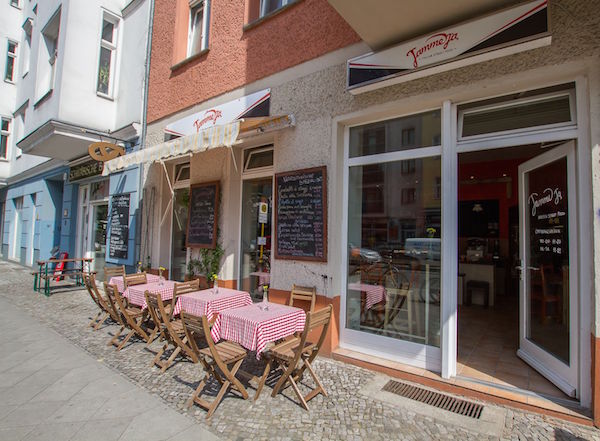
For Italian version please scroll down
Sometimes people in Berlin don’t believe how difficult it is for me to find an Italian restaurant I really can enjoy.
Even if there are many possibilities, the most of them offer kind of an international Italian cuisine, not the original one. I’m from Napels the place where the pizza was born, the place where you can eat the best spaghetti and pummarola, mozzarella, babà and sfogliatelle, so it is not easy to adapt my taste to some fake italian food. It is hard to understand it without knowing the long tradition of neapolitan kitchen.
During the Bourbon domination (1734-1861) Naples – capital of the Kingdom of the Two Sicilies – experienced a period of great economic and cultural development, becoming one of the most important cities in Europe.
All spheres were touched: from industry to social policies, from the development of infrastructure to culture, the Bourbons were enlightened and advanced.
Thanks to the steel industry in Mongiana, the Ferdinandea foundry in the Serre area in Calabria and the rail industry in Pietrarsa, between all of the States pre-unification, the Kingdom of the Two Sicilies was the richest one and the most industrialized.
In addition to having the first railway that linked Naples to Portici, the first locomotive factory in Italy (1839/1840) and the first to produce the rails, the largest naval industry was located in Naples, along with the first merchant fleet and the most important Italian military fleet, third in Europe, with only the British and French fleets ahead (it is no coincidence that the first Italian Maritime Code was the De Jorio Code, drawn up in 1781 by a lawyer from Procida).
To name but a few of the public schemes; the first bridge in Italy was constructed, the Real Ferdinand bridge over the Garigliano, built by Francesco I of Bourbon and completed in 1828; the gas street lighting (in 1837 Naples was the first Italian city to be equipped), and the first telegraph line, which in 1852 established communication between Naples and Gaeta.
Also, with regard to social policy, the Kingdom of the Bourbons was distinguished for its innovation and progress.
In 1751 by the will of Carlo of Bourbon, the first Hospice for the Poor – a monumental building – was built by Ferdinando Fuga. Then in 1819 health care for the elderly and disabled was institutionalised through the Code for the Kingdom of Two Sicilies.
Under the Bourbons, the first secular university in Italy was founded (the Kingdom boasted four universities, the largest number of university students, and more than 50% of all books published in Italy), the Seismological Observatory of Vesuvio (the first in the world), the Academy of Arts, the famous Conservatory of Music of San Pietro a Maiella, the oldest theater in Europe, 1737, the San Carlo in Naples (in 1860 the capital of the Kingdom was the city with the highest number of theatres).
In 1833 Ferdinando II inaugurated the first industrial pasta factory. Pasta production became a prerogative for some Vesuvian countries where the climate favors the natural drying of pasta.
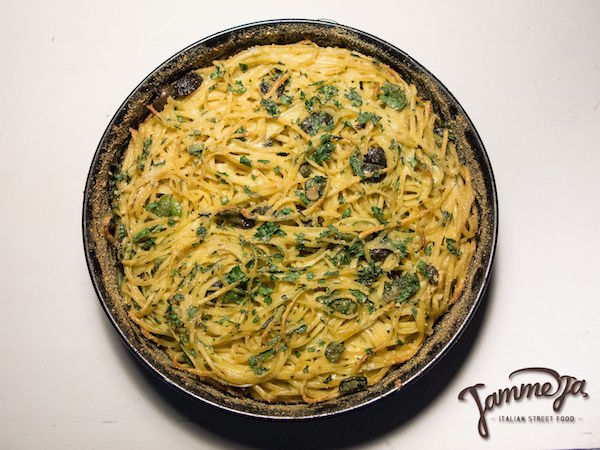
The birth to a new cuisine – the Monzù dynasty
In this climate of excellence and supremacy in every field, even the kitchen underwent a development that made it famous across national borders.
The Neapolitan cuisine, which was already well-known at the beginning of the fourteenth century (illustrated by Il Liber de coquina which was written one of King Carlo II d’Angiò’s courtiers in 1309) became recognised for its variety and richness during the French rule.
Its great success, especially during the nineteenth century onwards, is due precisely to the meeting between haute transalpine tastes and the local cuisine which already had Spanish and Arabic flavors.
Maria Carolina of Austria, wife of King Ferdinando IV of Naples, can take credit for this as she asked her sister Maria Antoinetta to send her the finest French chefs. And so the best chefs gave birth to the so-called Monzù dynasty (Monsieur in Neapolitan dialect).
The reciprocal gastronomical influences lead the way to a new cuisine, which managed to blend two traditions in the best way. The recipes were revised and transformed, lightening the French dishes from butter and sauces, and making the most common ones more elaborate and worthy of Royal tables all over Europe.
Although this culinary tradition was passed down primarily orally, there are important examples from the era of written recipes. Of particular historical value are La Cucina Napoletana by Vincenzo Corrado of 1832 and La Cucina teorico pratica (The theoretical and practical cousine) of 1837 by Ippolito Cavalcanti Duke of Buonvicino.
The Duke (descendant of the infamous Guido) subsequently added the Cusina casarinola in Neapolitan to The Essay of La Cucina teorico pratica.
In addition to the expert instructions on how to equip a kitchen and set the table, as well as the many tips on prepararing the different types of dough, some of the most famous Neapolitan recipes and dishes have been gathered and described in both essays, for example:
the zuppa maritata, soup made with different types of meats, sausages and vegetables from the fields around Vesuvius; the tympanum of macaroni (better known today as a timbale of macaroni), composed of several layers of pasta with sauce, cheese and meat, contained in the fragrant crust of the dough; parmigiana di melanzane, made of layers of fried aubergines, fresh tomato sauce and mozzarella; genovese sauce made of onions and meat; fried pizza, stuffed with ricotta cheese and cold cuts and many other culinary creations whose names derive directly from French, such as the sartù di riso, from sur-tout, because the rice is literally covered with meat sauce, peas, mushrooms, mozzarella , meatballs and sausages; the crocché, from French croquettes, panzarotti made of potatoes, eggs and cheese, wet with egg white, then covered in bread crumbs and fried, which today are still served in cuoppi (special sheets of paper rolled up) together with pastacresciute, fiorilli, scagliozzi, rice balls and eggplant which is gilded in flour and fried; ragù, from French ragout, which is a type of meat and vegetables cooked on a very low heat (in the Neapolitan recipe beef and pork stew are cooked in tomato sauce); the potato gâteau, more commonly called gattò, which consists of a sort of stuffed potato cake with meat and cheese, and many others things.
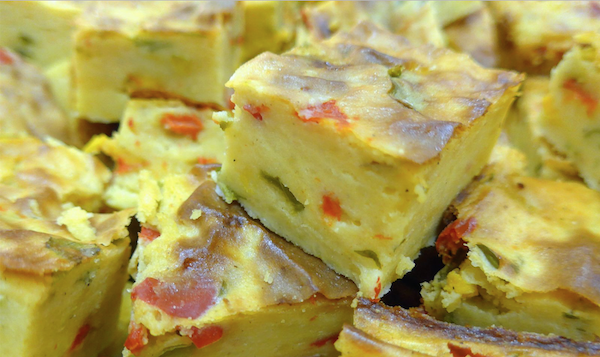
Even Goethe was in love with the neapolitan Cuisine
The richness and variety of this cuisine are recounted through literature of the same era.
In his Italian Journey J. W. Goethe, during one of his stays in Naples, was struck by the abundance and variety of every edible kind:
Aus der Italianische Reise:
Neapel den 29. Mai. 1787
Bei Santa Lucia sind die Fische nach ihren Gattungen meist in reinlichen und artigen Körben, Krebse, Austern, Scheiden, kleine Muscheln, jedes besonders aufgetischt und mit grünen Blättern unterlegt. Die Läden von getrocknetem Obst und Hülsenfrüchten sind auf das mannigfaltigste herausgeputzt. Die ausgebreiteten Pomeranzen und Zitronen von allen Sorten, mit dazwischen hervorstechendem Laub, dem Auge sehr erfreulich.
(In Saint Lucia various qualities of fish – shrimp, oysters, razor clams, small crustaceans – are usually each presented in a nice clean basket and on a bed of green leaves. The dried fruit shops and legumes are decorated with fanciful varieties; a huge spread of oranges and lemons of all species, with the green foliage that protrude nicely between them.).
Die Makkaroni, ein zarter durchgearbeiteter, gekochter, in gewisse Gestalten gepresster Teig von feinem Mehle, sind von allen Sorten überall um ein geringes zu haben. Sie werden meistens nur mit Wasser abgekocht, und der geriebene Käse schmälzt und würzt zugleich die Schüssel. Fast an der Ecke jeder großen Straße sind die Backwerkverfertiger mit ihren Pfannen voll siedenden Öl, besonders an Festtagen, beschäftigt, Fische und Backwerk einem jeden nach seinem Verlangen sogleich zu bereiten.
(Macaroni, a kind of cooked pasta made from thin flour; soft and well-crafted, which is molded into various shapes; you can buy all sorts everywhere for very little money. It is usually cooked in plain water, and grated cheese anoints the plate and at the same time seasons it. At nearly every corner of the high street there are the friggitore with pans full of boiling oil, ready to prepare food on the spot, especially during holidays; fried fish and pancakes depending on the requests of passersby.)
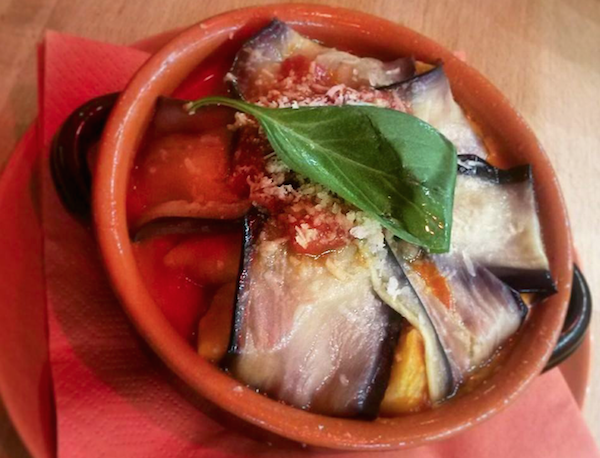
It’s incredible how through food you can narrate a part of history and rebuild the geography of a place. The use of the vegetables in the kitchen tells us about the climate and fertility of the land, eating fish signifies being close to the sea, meat during certain eras was comparable to using gold or painting with blue pigment blue; it expresses the richness of a country.
„Jamme Ja“: „come on, let’s go“
And that is precisely what Stefania is trying to do in Berlin. She is one of the owners of the trattorie Jamme Ja, which, through its dishes, inspired by the Neapolitan culinary tradition of the 1800s, attempts to tell the history of a place by enhancing familiarity with the products and recounting the recipes’ origins.
Despite some difficulties in obtaining raw materials, Stefania (who was a pupil of chef Antonio Tubelli, undisputed master of fried food and owner of the famous Timpani and Tempura restaurant in the historic centre in Naples) decided to revive some ancient dishes without changing their essence. Stefania has not succumbed to the temptation to alter the recipes to make them more accessible and international. On the contrary, her restaurant invites Berliners on a daily basis to try something new and she tries to educate their palates to different tastes. Jamme Ja, which in Neapolitan means ‚come on, let’s go‘, is simply an exhortation to experience the flavors of the Neapolitan tradition.
With great satisfaction and great success, this choice has been rewarded. After the initial reluctance towards dishes that are difficult to understand, now diners are discovering the goodness of frittata di maccheroni (macaroni omelette), of timballo or gattò.
Despite not being able to respect the philosophy of km 0 (according to which you should only cook with local and seasonal products) Stefania – who attended the Cucina Amica school of cooking in Naples – has, however, endeavoured to honour the authenticity of flavors through sourcing the original products.
Finding the Vesuvius tomato ‚o piennolo, that in Naples can be seen hanging out balconies, or fresh Sanmarzano (considering that the canning of food was born in Naples, that now brings tomatoes and tomato paste to the rest of the world…), finding friarielli to accompany the sausages, the scarola for soups, pizzas and salads, or the zucchini flowers to be fried and stuffed with ricotta cheese, being able to buy a good buffalo mozzarella, fior di latte, a fresh provola cheese, a scamorza, the typical Sorrentino delicacy provolone or the Agerola ricotta, tracking down some cicinielli at the fish counter, or alici (fresh anchovies) and fragagli for the Sunday frittura or fresh and aromatic blue fish; here in Berlin it’s an impossible task!
But this does not seem to limit Stefania, who has come to know and to use the vegetables and local products in accordance with the weather and seasons. The rest she has sent over to her from all over Italy.
Her Friday aperitif is a new-found habit for all Italians in the city and one that even the Germans have begun to value.
Among the daily specials and a spritz, you can start the weekend in the tastiest way!
So jamme ja, do not hesitate. All should make a journey into history through the scents and flavors of tasty food!!!
ITALIAN VERSION
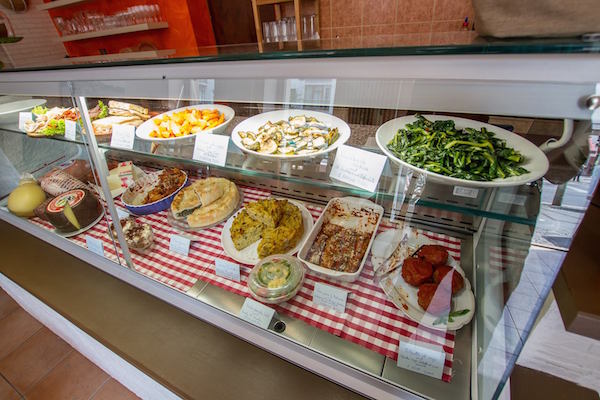
Spesso i miei amici a Berlino non capiscono quanto per me sia complicato trovare un ristorante italiano che mi piaccia realmente.
Anche se ci sono molte possibilità, la maggiore parte dei restoranti offre una cucina italiana internazionale, molto lontana dai sapori cui sono abituato. Sono di Napoli, il luogo in cui è nata la pizza, la città degli spaghetti con la pummarola, della mozzarella, dei babà e delle sfogliatelle, per cui è difficile adattare il mio gusto a qualche piatto che di originale ha solo il nome. Per comprendere le difficoltà del mio palato, bisognerebbe conoscere la lunga tradizione della cucina napoletana.
Durante la dominazione borbonica (1734-1861) Napoli – capitale del Regno delle due Sicilie – ha vissuto un periodo di grande sviluppo economico e culturale, divenendo una delle più importanti città d’Europa.
In tutti gli ambiti: dall’imprenditoria alle politiche sociali, dallo sviluppo delle infrastrutture alla cultura, i Borboni furono illuminati e all’avanguardia.
Grazie al polo siderurgico di Mongiana, alla fonderia Ferdinandea nella zona delle Serre in Calabria, e all’opificio ferroviario di Pietrarsa, tra tutti gli Stati preunitari, il Regno delle due Sicilie era quello più ricco e industrializzato.
Oltre ad avere la prima rete ferroviaria che collegava Napoli a Portici, la prima fabbrica di locomotive d’Italia (1839/1840) e a produrre le prime rotaie, a Napoli aveva sede la più grande industria navalmeccanica, la prima flotta mercantile, nonché la più importante flotta militare d’Italia, terza in Europa solo rispetto a quelle britannica e francese (non è un caso che il primo Codice Marittimo Italiano sia il Codice De Jorio, redatto nel 1781 da un giurista procidano).
Nell’ambito delle opere pubbliche furono realizzati: il primo ponte in Italia, il ponte Real Ferdinando sul Garigliano, voluto da Francesco I di Borbone e ultimato nel 1828; l’illuminazione stradale a gas (nel 1837 Napoli fu la prima città italiana a esserne dotata), e la prima linea telegrafica, che nel 1852 mise in comunicazione Napoli a Gaeta.
Anche per quanto riguarda le politiche sociali, il Regno dei Borbone si distinse per innovazione e progresso. Nel 1751 fu fondato, per volontà di Carlo di Borbone, il primo Albergo dei Poveri (edificio monumentale realizzato da Ferdinando Fuga) e, nel 1819 fu istituita l’assistenza sanitaria per anziani e inabili, prevista dal Codice per il Regno delle Due Sicilie.
Sotto i Borbone fu fondata la prima Università laica d’Italia (il Regno vantava quattro università, il maggior numero di studenti universitari, e più del 50% dei libri pubblicati in Italia), l’Osservatorio Sismologico Vesuviano (primo al mondo), l’Accademia delle Belle Arti, il famoso Conservatorio di Musica San Pietro a Maiella, il più antico teatro d’Europa, del 1737, il San Carlo di Napoli (nel 1860 la capitale del Regno era la prima città per numero di teatri).
Nel 1833 Ferdinando II di Borbone inaugurò il primo pastificio industriale. La produzione della pasta divenne una prerogativa di alcuni paesi vesuviani in cui il clima favorisce l’essiccazione naturale della pasta.

La nascita di una nuova cucina – la dinastia dei Monzù
In questo clima di eccellenze e primati in ogni campo, anche la cucina ebbe uno sviluppo che la rese famosa oltre i confini nazionali.
Già conosciuta all’inizio del Trecento, come testimonia Il Liber de coquina scritto da un cortigiano del re Carlo II d’Angiò nel 1309, la cucina napoletana durante la dominazione francese si distinse per varietà e ricchezza.
Il suo grande successo, soprattutto dall’Ottocento in poi, si deve proprio all’incontro fra l’alta gastronomia d’oltralpe e quella locale che già aveva contaminazioni spagnole e arabe.
Il merito di ciò va attribuito a Maria Carolina d’Austria, moglie del re Ferdinando IV di Napoli, la quale chiese alla sorella Maria Antonietta di inviarle i più raffinati cuochi francesi. Fu così che i migliori chef diedero vita alla così detta dinastia dei Monzù (Monsieur nel dialetto napoletano).
Le reciproche influenze gastronomiche favorirono la nascita di una nuova cucina, che riuscì a fondere nel migliore dei modi le due tradizioni. Le ricette furono riviste e trasformate, alleggerendo quelle francesi da burro e salse, e rendendo quelle popolari più elaborate e degne delle tavole coronate di tutta Europa.
Sebbene questa tradizione culinaria fosse tramandata soprattutto verbalmente, ci sono importanti testimonianze scritte delle ricette dell’epoca. Di particolare valore storico sono La Cucina Napoletana di Vincenzo Corrado del 1832 e La Cucina teorico pratica del 1837 di Ippolito Cavalcanti Duca di Buonvicino.
Al Trattato di Cucina Teorico-Pratica, Ippolito Cavalcanti (discendente del più famoso Guido) in seguito aggiunse anche l’appendice Cusina casarinola in lingua napoletana.
Oltre alle sapienti istruzioni su come equipaggiare e apparecchiare una cucina, e alle numerose indicazioni per le preparazioni dei diversi impasti, in entrambi i trattati sono state raccolte e descritte le ricette di alcuni dei più famosi piatti della tradizione partenopea, quali: la minestra maritata, brodo fatto con diversi tipi di carni, salumi e verdure degli orti vesuviani; il timpano di maccheroni (oggi meglio conosciuto come timballo di maccheroni), composto da diversi strati di pasta condita con sugo, formaggi e carne, contenuti in una fragrante crosta di pasta brisé; la parmigiana di melanzane, fatta di strati di melanzane fritte, sugo di pomodori freschi e mozzarella; la genovese, sugo fatto di cipolle e carne; la pizza fritta, imbottita di ricotta formaggio e salumi e molte altre creazioni culinarie i cui nomi derivano direttamente dal francese, come il sartù di riso, da sur-tout, perché il riso veniva letteralmente ricoperto da ragù, piselli, funghi, fior di latte, polpette e salsicce; i crocché , dal francese croquettes, panzarotti fatti di patate, uova e formaggio, bagnati nell’albume d’uovo, nel pan grattato e poi fritti, che tutt’ora vengono serviti nei cuoppi (appositi fogli di carta arrotolati) insieme a pastacresciute, fiorilli, scagliozzi di semola, palle di riso e melanzane indorate e fritte; il ragù, dal francese ragout, che indica un tipo di cottura a fuoco molto lento di carne e verdure (nella ricetta napoletana carni bovine e suine vengono fatte stufare nel sugo di pomodoro); il gâteau di patate, più comunemente detto gattò, che consiste in una sorta di torta di patate imbottita di salumi e formaggi, e tante altre ancora.
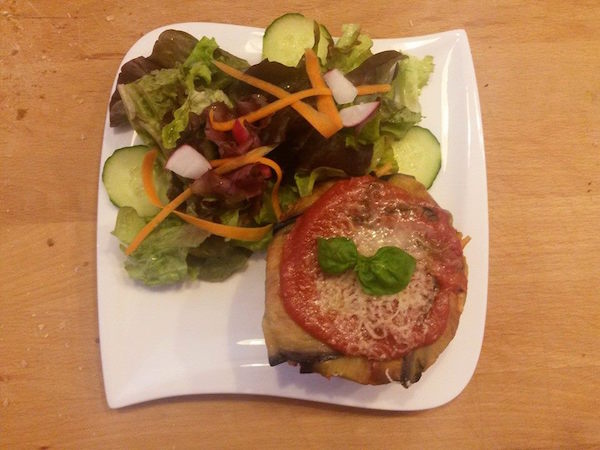
Goethe e la cucina napoletana
La ricchezza e la varietà di questa cucina sono raccontate anche dalla letteratura dell’epoca.
Nel suo Viaggio in Italia J. W. Goethe, durante uno dei suoi soggiorni a Napoli, venne colpito dall’abbondanza e dalla varietà di ogni genere commestibile:
Aus der Italianische Reise:
Neapel den 29. Mai. 1787
Bei Santa Lucia sind die Fische nach ihren Gattungen meist in reinlichen und artigen Körben, Krebse, Austern, Scheiden, kleine Muscheln, jedes besonders aufgetischt und mit grünen Blättern unterlegt. Die Läden von getrocknetem Obst und Hülsenfrüchten sind auf das mannigfaltigste herausgeputzt. Die ausgebreiteten Pomeranzen und Zitronen von allen Sorten, mit dazwischen hervorstechendem Laub, dem Auge sehr erfreulich.
(A Santa Lucia le varie qualità di pesci – gamberi, ostriche, cannolicchi, piccoli crostacei – vengono presentate di solito ciascuna in una bella cesta pulita e su uno strato di foglie verdi. Le botteghe di frutta secca e di legumi sono decorate con fantasiosa varietà. Distese d’arance e di limoni di tutte le specie, con le verdi fronde che sporgono piacevolmente frammezzo.).
Die Makkaroni, ein zarter durchgearbeiteter, gekochter, in gewisse Gestalten gepresster Teig von feinem Mehle, sind von allen Sorten überall um ein geringes zu haben. Sie werden meistens nur mit Wasser abgekocht, und der geriebene Käse schmälzt und würzt zugleich die Schüssel. Fast an der Ecke jeder großen Straße sind die Backwerkverfertiger mit ihren Pfannen voll siedenden Öl, besonders an Festtagen, beschäftigt, Fische und Backwerk einem jeden nach seinem Verlangen sogleich zu bereiten.
(I maccheroni, specie di pasta di farina sottile da cuocere, morbida e ben lavorata, che viene foggiata in diverse forme; dappertutto se ne può acquistare d’ogni genere per pochi soldi. Si cuociono di solito in semplice acqua, e il formaggio grattugiato unge il piatto e nello stesso tempo lo condisce. A quasi tutti gli angoli delle maggiori vie stanno poi i friggitori con le padelle piene d’olio bollente, pronti a preparare su due piedi, specie nei giorni di festa, pesci fritti e frittelle a seconda delle richieste dei passanti.)
È sorprendente come attraverso il cibo si possa raccontare una parte di storia e ricostruire la geografia di un territorio. L’uso delle verdure in cucina ci parla del clima e della fertilità del terreno, la presenza del pesce sulle tavole ci dice della vicinanza al mare e dell’attitudine alla pesca, l’uso della carne in determinate epoche è un po’ come l’uso dell’oro o dell’azzurro nella pittura: esprime la ricchezza di un popolo.
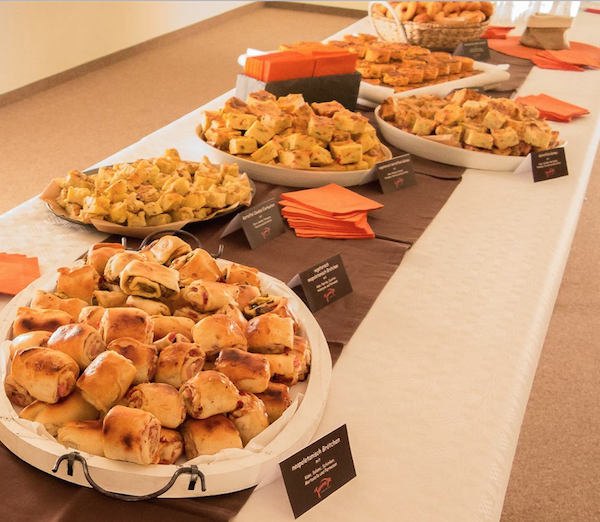
„Jamme Ja“: „come on, let’s go“
Ed è proprio quello che a Berlino si impegna a fare Stefania, una dei proprietari della trattoria Jamme Ja, la quale, attraverso i suoi piatti ispirati alla tradizione culinaria napoletana del 1800, cerca di raccontare la storia di un territorio, facendone conoscere i prodotti e raccontando l’origine delle sue ricette.
Nonostante alcune difficoltà nel reperire le materie prime, Stefania, allieva dello chef Antonio Tubelli, maestro indiscusso della frittura e titolare del famoso ristorante Timpani e Tempura nel cuore del centro storico di Napoli, ha deciso di riproporre alcune antiche pietanze senza cambiarne l’essenza. Non ha ceduto alla tentazione di modificare le ricette per renderle più fruibili e internazionali, al contrario, con la sua trattoria, invita quotidianamente i berlinesi a provare qualcosa di nuovo, cerca di educare i loro palati a gusti diversi. Jamme Ja, che in napoletano significa ‘andiamo su’, vuole essere proprio una esortazione a sperimentare i sapori della tradizione napoletana.
Con sua grande soddisfazione e un buon successo, questa scelta è stata premiata. Superata la ritrosia iniziale davanti a piatti difficili da capire, ecco scoprire la bontà di una frittata di maccheroni, del timballo o del gattò.
Stefania, che a Napoli si è formata presso la scuola Cucina Amica, se, suo malgrado, non può rispettare la filosofia del km 0 (secondo cui bisognerebbe cucinare solo con prodotti locali e stagionali) cerca comunque di difendere l’autenticità dei sapori attraverso la ricerca dei prodotti originali.
Reperire il pomodorino vesuviano detto ‚o piennolo, che a Napoli si può vedere appeso fuori a qualche balcone, o i Sanmarzano freschi (si pensi che Napoli è sorta l’industria conserviera che ha portato in tutto il mondo i pelati e il concentrato di pomodoro), trovare i friarielli da fare con le salsicce, la scarola per minestre, pizze e insalate, o i fiori di zucca da friggere ripieni di ricotta e formaggio, riuscire a comprare una buona mozzarella di bufala, del fior di latte, una provola fresca, una scamorza, un tipico provolone di Sorrento o della ricotta di Agerola, riuscire a trovare al bancone del pesce i cicinielli, le alici e i fragagli per la frittura domenicale o del pesce azzurro fresco e profumato, qui a Berlino è impresa impossibile!
Ma questo sembra non essere più un limite per Stefania, la quale ha imparato a conoscere e a utilizzare le verdure e i prodotti locali, nel rispetto del clima e delle stagioni e, per il resto a farsi spedire tutto dall’Italia.
Il suo aperitivo del venerdì per tutti gli italiani è una ritrovata abitudine che adesso anche i tedeschi iniziano ad apprezzare.
Tra le specialità del giorno e uno spritz, si può iniziare il weekend nel più gustoso dei modi!
Quindi, jamme ja, non esitate e fate tutti un viaggio nella storia attraverso i profumi e i sapori di una cucina prelibata!!!
